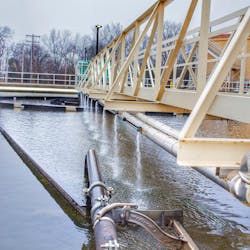OU study expands understanding of bacterial communities for wastewater treatment
OKLAHOMA, JUNE 13, 2019 -- A University of Oklahoma-led interdisciplinary global study expands the understanding of activated sludge microbiomes for next-generation wastewater treatment and reuse systems enhanced by microbiome engineering. Wastewater treatment and reuse are critical to global health and sustaining a world population predicted to reach 10 billion by 2050.
"In May 2014, we established a Global Water Microbiome Consortium as a way to promote international collaboration and communication on global research and education for water microbiome," said Jizhong Zhou, OU director, Institute for Environmental Genomics; George Lynn Cross Research Professor, OU College of Arts and Sciences; adjunct professor, Gallogly College of Engineering; adjunct senior scientist, Lawrence Berkeley National Laboratory; and adjunct professor, Tsinghua University.
"Different from several other global initiatives using a bottom-up approach to solicit microbial samples, the consortium used top-down sampling strategy to target the microbiomes of activated sludge processes in municipal wastewater treatment plants that represent a vital element of the infrastructure for modern urban societies. The campaign involved 111 investigators who sampled 269 wastewater treatment plants in 86 cities in 23 countries on six continents," said Zhou.
This study is novel in several ways: (1) it reports the first comprehensive, highly coordinated effort to examine the global diversity and biogeography of the activated sludge microbiome; (2) it documents a highly diverse activated microbiome, containing up to one billion microbial phylotypes comprise of novel species; (3) it identifies the core global taxa of activated sludge microbial communities that are linked to activated sludge performance; (4) it reveals that the activated sludge microbiome is distinct from microbiomes in other habitats; and (5) it provides an understanding of the mechanisms driving the composition and functions of the activated sludge communities.
Each day wastewater is treated by an activated sludge process in municipal wastewater treatment plants and returned to the environment for use. This treatment process has been used for over a century and today represents the largest application of biotechnology in the world, yet there has been no effort to map the global activated sludge microbiome. Developing a fundamental understanding of the biodiversity of the activated sludge microbiome in relationship to performance is critical to advancing and optimizing this key technology for maintaining environmental health.
"This unprecedented global sampling effort yielded new insight into the microbiology of activated sludge," said Bruce Rittmann, director, Biodesign Swette Center for Environmental Biotechnology, Arizona State University. "Despite giant geographic differences, the microbial communities of activated sludge have a core of about 28 bacterial strains, which reflects the powerful and unique ecological selection of the activated sludge process."
"This expansive study is the first time that a systematic study of the hugely beneficial microbial communities involved in the biological treatment of daily wastewaters from communities around the world have been studied to understand their fundamental structure and function has been undertaken. It represents an important development in understanding and maintaining these crucial microbial communities," said Lisa Alvarez-Cohen, Fred and Claire Sauer Professor, University of California Berkeley, and adjunct senior scientist, Lawrence Berkeley National Laboratory.
A paper on this research, "Global Diversity and Biogeography of the Bacterial Communities in Wastewater Treatment Plants," has been published in Nature Microbiology.
